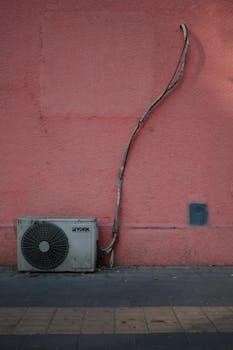Safety Precautions
Always adhere to the Daikin installation manual. Improper installation can cause water leaks, electrical shocks, or fire hazards. Careful work is essential for safety and proper function.
Ignoring installation guidelines may lead to water leakage, electric shock, or fire. Using non-specified parts can also result in malfunctions and compromise safety standards.
When installing in small spaces, ensure refrigerant concentration stays within safe limits. Excessive leaks pose dangers; follow proper procedures to maintain a safe level.
Importance of Following Installation Manual
Adhering to the Daikin installation manual is paramount for a safe and efficient setup. The manual provides crucial step-by-step instructions, ensuring each component is correctly installed and connected. Failure to follow these guidelines can lead to severe consequences, including water leakage, electrical shocks, and even fire hazards. Proper installation, as outlined in the manual, guarantees the system operates at its designed performance level. It also helps to avoid any potential damage to the unit and surrounding property. The manual specifies the correct parts and procedures, preventing the use of incompatible accessories. This is important for the long-term reliability and safety of the Daikin mini-split system. Ignoring the manual may lead to voiding warranties and additional expenses. By carefully following the manual, installers can ensure optimal performance and safety.
Risks of Improper Installation
Improper installation of a Daikin mini-split system carries significant risks, potentially leading to serious issues. Water leakage can occur if drain pipes are not correctly installed, causing damage to walls and floors. Electrical shocks are a severe danger if wiring is not done per the manual’s guidelines or if grounding is inadequate. Furthermore, incorrect installation can result in fire hazards, especially when electrical connections are faulty or overstressed. Using non-specified parts may cause system malfunctions, reduce efficiency, or even lead to complete system failure. Ignoring specified procedures can also void warranties, leaving the homeowner responsible for costly repairs. Careful adherence to the installation manual is crucial to avoid these dangers and ensure the safe and effective operation of the system.
Refrigerant Safety Limits
When installing a Daikin mini-split system, it’s crucial to be aware of refrigerant safety limits, especially in small rooms. Excessive refrigerant leaks, if not addressed, can lead to health risks and environmental concerns. The installation manual specifies the allowable concentration of refrigerant in different spaces, and these limits must be strictly adhered to. Exceeding these limits can cause the refrigerant to displace oxygen, potentially resulting in suffocation. Therefore, during installation, ensure that proper ventilation is maintained to prevent dangerous build-up. Carefully check all connections to avoid leaks and monitor the system after installation to confirm no refrigerant loss. Following safety guidelines is essential to a safe and efficient operation.
Pre-Installation
Before installation, verify that the unit’s rated voltage matches the power supply. Incorrect voltage can damage the system; confirm compatibility to ensure proper function.
Adequate ventilation is essential for safe operation. Open windows or doors during installation to minimize risks of refrigerant build-up and maintain a safe environment.
Install the air conditioner or heat pump on a solid foundation, strong enough to support the unit. This prevents vibration, noise and ensures stability.
Checking Voltage Compatibility
Before commencing any electrical work, it is paramount to meticulously check that the rated voltage of the Daikin mini-split unit aligns precisely with the available power supply at the installation site. This critical step is essential for preventing potential damage to the system. Refer to the unit’s nameplate for the specific voltage requirements and ensure that they match the local electrical specifications. Incompatibility in voltage can lead to malfunctions, reduced performance, or even complete failure of the unit and compromise safety. Therefore, double-checking the voltage compatibility is a must before proceeding with any further steps in the installation process, to ensure a successful and safe operation. This step is not optional but is a required measure.
Ensuring Proper Ventilation
Prior to the installation of a Daikin mini-split system, ensuring adequate ventilation is a crucial step that must not be overlooked. Proper ventilation in the installation area is essential to minimize any risks of ignition and also to provide a safe environment for working with equipment. This can be achieved by opening windows and doors to allow a good flow of fresh air. Inadequate ventilation can create a buildup of refrigerant, posing health and safety risks. It is extremely important to avoid working in enclosed or confined spaces where ventilation is limited. By ensuring proper ventilation, one can minimize any potential risks of fire and other safety hazards, thus facilitating a safe and smooth installation process. Always prioritize good airflow to make a safe workspace.
Foundation Requirements
The installation of a Daikin mini-split system requires a solid and appropriately prepared foundation. The air conditioner or heat pump unit must be placed on a surface that can adequately support its weight and also withstand its vibrations during operation. A weak foundation can lead to damage to the unit, improper functionality, and safety concerns. It is very important that the foundation is level to prevent any issues of drainage or operational errors. For outdoor units, a concrete pad or a similar stable surface is typically recommended to ensure a stable and lasting installation. The chosen foundation should also be appropriate for the specific unit’s requirements to maintain stability and ensure optimal performance and longevity;

Installation Process
Always utilize the specified accessories and parts during Daikin mini-split installation. Using incorrect components may result in malfunctions and safety hazards.
Securely connect refrigerant piping, following the manual for proper techniques. Incorrect connections may cause leaks, impacting system performance and efficiency.
Install drain piping carefully to ensure proper drainage and avoid water leakage. Following the instructions will prevent any potential water damage.
Using Specified Accessories and Parts
During the installation of your Daikin mini-split system, it is absolutely critical to use only the accessories and parts that are specifically designated by Daikin. This is not merely a suggestion, but a strict requirement for the safe and efficient operation of your unit. Using non-specified components can lead to a variety of issues, including but not limited to, system malfunctions, reduced performance, and potential safety hazards such as water leaks, electrical shorts, or even fire. Daikin designs and tests its products with particular components to ensure compatibility and longevity. Substituting these parts introduces unknown variables that can compromise the integrity of the system and void your warranty. Therefore, meticulous attention to detail is crucial when gathering the necessary items, and always cross-reference with the official installation manual.
Connecting Refrigerant Piping
Properly connecting the refrigerant piping is a vital step when installing a Daikin mini-split system. This process demands precision and adherence to the manufacturer’s guidelines to ensure a leak-free and efficient system. Before making any connections, confirm that all pipes are clean and free of any debris that might contaminate the refrigerant circuit. Use the appropriate tools and techniques to make secure, tight connections, and ensure that the correct flare fittings are used. Carefully follow the instructions provided in the installation manual for specific torquing specifications. Failing to properly connect the piping can result in refrigerant leaks, reduced system performance, and environmental harm, and may void your warranty. Always, double-check each connection before charging the system with refrigerant and follow the prescribed procedure.
Drain Piping Installation
The correct installation of drain piping is crucial for a Daikin mini-split system to function effectively and prevent water damage. This process requires careful attention to detail and adherence to the manufacturer’s guidelines in the installation manual. Ensure that the drainpipe slopes downward to allow for proper water drainage. Avoid any dips or obstructions that could cause water to accumulate, leading to leaks or water damage. Use the correct pipe size and material, as specified in the manual, and secure the connections with appropriate fittings. Pay close attention to the routing of the drain line, to avoid any kinks or bends that could restrict water flow. Test the drainage system after installation to confirm that water flows freely and effectively away from the unit. Following these steps is very important for proper operation.

Electrical Wiring
Always follow the Daikin wiring diagram precisely. Incorrect connections can lead to malfunctions or damage. Ensure the voltage matches the unit’s specifications.
When using a GFI breaker, ensure compatibility. Some Daikin units may not require a neutral wire. Consult the manual for proper GFI installation guidelines.
Wiring Diagram Adherence
Strictly adhere to the wiring diagram provided in the Daikin installation manual. This diagram is crucial for the safe and correct operation of your mini-split system. Verify that all wire connections match the diagram’s specifications. Mismatched wiring can cause electrical issues, potentially leading to system failure or, worse, a fire hazard. Before beginning, double-check the voltage requirements and compare them with your power supply. Improper voltage can damage the unit’s components. Make sure all connections are secure and correctly placed, paying special attention to grounding wires. Never deviate from the prescribed wiring layout; doing so may void your warranty and endanger your safety. If you are unsure about any aspect of wiring, seek assistance from a qualified electrician or HVAC professional.
GFI Breaker Considerations
When installing a Daikin mini-split, consider the use of a Ground Fault Interrupter (GFI) breaker. These breakers are designed to protect against electrical faults that can cause shocks. Some local codes or regulations may mandate their usage, especially in damp or outdoor locations. While GFI breakers offer enhanced safety, they may also trigger nuisance trips if the system experiences minor fluctuations. The Daikin condenser unit typically doesn’t have a neutral connection, which might complicate the use of standard GFI breakers. Carefully evaluate whether a GFI is needed and if it’s compatible with your specific Daikin model. Consult with a qualified electrician to select the correct type of GFI breaker for your installation. Ensure that the GFI breaker meets the proper voltage and amperage requirements of your mini-split system. Improper selection could lead to malfunction or failure.

Post-Installation
After installation, run a trial operation to check for proper functioning. Look for any faults and ensure the system operates correctly. Address any issues immediately.
Instruct the user on how to operate and maintain the unit. Provide guidance on basic functions and care to ensure the system’s longevity.
Trial Operation and Fault Checks
Following the completion of the physical installation, it is imperative to conduct a thorough trial operation of the Daikin mini-split system. This critical step allows for the verification of correct functionality and the identification of any potential faults that may have arisen during the installation process. During this trial, carefully observe the system’s performance across all operational modes, including cooling and heating. Pay close attention to the airflow, temperature adjustments, and overall system responsiveness. It is essential to monitor for any unusual noises, vibrations, or error codes that may indicate a problem. Should any issues emerge, consult the Daikin installation manual for troubleshooting guidance and, if necessary, seek assistance from a qualified HVAC technician to rectify the fault promptly. This diligent approach will ensure optimal system performance and longevity.
Customer Instructions
After successfully completing the Daikin mini-split installation and the trial operation, it is crucial to provide the customer with comprehensive instructions on how to properly operate and maintain their new system. These instructions should cover basic operational procedures, including how to adjust temperature settings, switch between different modes (cooling, heating, fan), and use any special features, such as timers or sleep modes. Additionally, it is essential to explain the importance of regular maintenance, such as cleaning the air filters, and to guide customers on how to perform these tasks correctly. Clear instructions on troubleshooting basic error codes should be provided, as well as guidance on when to contact a qualified technician for assistance. By ensuring customers are well-informed, they can maximize the lifespan and efficiency of their Daikin mini-split system, while maintaining optimal comfort.

Additional Information
Access Daikin’s official website for manuals and resources. Find detailed installation guides, specifications, and support information for your specific model.
Daikin is a leading manufacturer of mini-split systems, offering quality, energy-efficient solutions. Their technology is designed for optimal home comfort and performance.
Ductless mini-splits offer flexible installation, energy savings, and zone control. They are a great alternative to traditional HVAC systems, offering many advantages.
Daikin Manuals and Resources
For comprehensive guidance, always refer to official Daikin manuals. These resources provide detailed installation instructions, troubleshooting tips, and safety guidelines. Access these manuals through the Daikin website, ensuring you have the correct version for your specific model. Daikin offers a range of documentation including installation manuals, service manuals, and engineering data sheets. These resources are essential for proper setup and maintenance of your mini-split system. Utilizing the correct manual prevents improper installation, which can cause equipment damage or safety hazards. Explore the Daikin website to find additional support, product information, and warranty details. By having these resources you will ensure proper installation and operation of your system. Remember that using the proper tools and accessories specified by Daikin is crucial, and this is detailed in the manuals.
Daikin Mini Split System Overview
Daikin mini-split systems are known for their high-quality and energy-efficient heating and cooling solutions. These systems, which include both indoor and outdoor units, offer flexible climate control for various building types; The key components involve an outdoor condenser unit and one or more indoor units connected by refrigerant piping. Daikin is a leading manufacturer of mini-split AC systems worldwide, specializing in Variable Refrigerant Volume (VRV) technology. Their systems are designed to provide comfort and convenience in a range of applications. Proper installation is crucial for optimal performance, and Daikin offers a range of installation manuals and resources. These systems are also available in both single-zone and multi-zone configurations to meet diverse needs. Daikin units often use R410A or R32 refrigerants and come with various features like remote controllers.
Ductless System Advantages
Ductless mini-split systems, such as those offered by Daikin, provide several advantages over traditional HVAC systems. One major benefit is the absence of ductwork, which reduces energy loss and improves efficiency. These systems allow for zone-specific heating and cooling, offering customized comfort in different areas of a building. Ductless systems are also easier to install, requiring only a small hole for refrigerant piping and electrical wiring. This reduces installation time and costs, making them suitable for both new construction and retrofits. Additionally, ductless systems are known for their quiet operation and improved indoor air quality. These systems are a flexible and efficient choice for both residential and commercial applications, offering a modern alternative to conventional central air. Furthermore, these systems can be installed in diverse locations due to the flexibility of the indoor unit placement.


